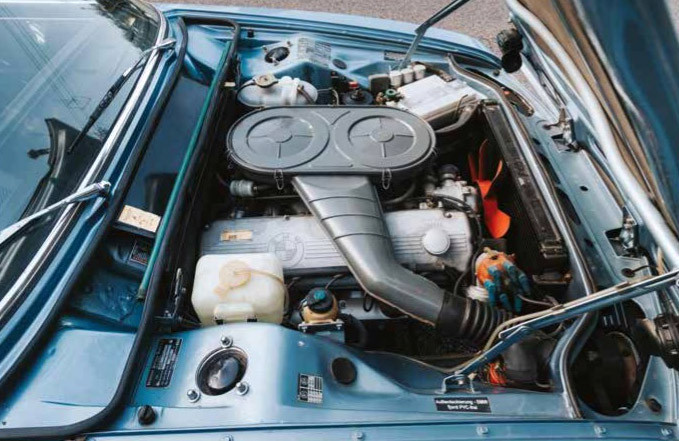1972 BMW 3.0 S Manual gearbox E3
We take a rare and restored E3 BMW 3.0 S sedan for a drive and are reminded what these gems were like 50 years ago.
By: Wilhelm Lutjeharms WLutjeharms
Photos: Peet Mocke Petridish_Mooks
NEW SIX
Its model range might be called E3, but it is also known as the New Six. The launch of the E3 (called E9 for the coupé range) marked the return of the inline six-cylinder engine for BMW, an important range back then. Its code name was M30 and the range formed the basis of a variety of engine capacities and powered some notable sports and racing cars in the process as well.

Since its restoration around 13 years ago, this beautiful E3 series BMW has done just over 2 000 km. That is evident in the condition of the car. As the owner states: “The previous owner restored it around 2009 and subsequently won quite a few awards through the BMW Club.” Up close, the car looks the part. It might not be one of BMW’s sportscars, but there is still a naturally sporty attitude, thanks largely to the 3,0-litre, straight six-cylinder engine under the hood.

Climb inside and the wood veneer is a remarkable contrast to the darker blue interior. The classy blue vinyl adds to the luxury feel of the cabin; it is just so much prettier than all-black and complements the exterior. Details include the headrests, neatly elevated above the seat with two supporting arms. Once seated, you can hear the tick-tock of the clock.
The heavy, solid thud as you close the door is unique to classic cars. I opened the door to take a look at the sticker, which confirmed the exterior colour is Fjord Blue. Apart from the thin steering wheel, there is also that beautiful gear lever. I have driven a 3,2-litre CSL and 2002tii from this era and know how sporty these classic BMWs can be, and this more conventional BMW sedan didn’t disappoint.

The Alpina-styled wheels wrapped in 205/70 R14 tyres are aesthetically pleasing. The front bumper is not the original unit, but rather a period-correct unit from an E9 coupé. Both suit the car to a T and give it an even sportier stance. These wheels are also slightly wider than the originals fitted at the factory.
The ride is good and comfort is as you would expect from such a classic. There is already a great deal of torque available from just above 2 000 r/min, while the engine and Zenith carburettors come alive around the 4 000 r/min mark and head with urgency towards the redline at 6 500 r/min. The gear lever easily switches between the ratios and there is a mechanical feel to the shift action. The steering is similar: fairly heavy, but impressively communicative. This car has been fitted with a five-speed BMW gearbox, instead of the original four-speed. Purists might frown but the result is that the engine revs are lower once on the open road, while in town there are more gears to play with. The glasshouse is much larger than in modern vehicles and presents a perfect view through the windows. That bonnet reveals the sharper lines in the side that run all the way to the front headlights.

A classic car requires documents and the owner’s manual, which is always interesting to page through, was present in the glove compartment.
The owner is a motoring enthusiast and has a specific taste in cars, but at the same time, he has a deep love and appreciation for the BMW marque. “I bought it just before Christmas in 2021. The previous owner put a lot of work into it and used original parts during the restoration, even the labels and stickers.”
The main reason he bought the 3.0 S is simply to be able to try different cars. “I’ve had a fascination with these early BMWs for a long time. I like the sound of the whine of the first gear; it is very BMW and brings back good memories. My godfather had an E12 535i manual that had the same whine. When the time comes, I might sell it and try something else. However, it is a lot better than I expected it to be. It’s quite modern and it’s hard to believe it will be 50 years old this year.”

As I parked and hopped out for a final chat with the owner, I realised what a magical era this was for BMW in terms of the cars it offered and their success on the European tracks and hill climbs. These models laid the foundation for the cars that followed in the later 1970s and early 1980s that we aspired to own.
TECHNICAL DATA 1972 BMW 3.0 S Manual gearbox E3
- Engine: 2 985 cm3, six-cylinder, petrol M30
- Transmission: 4-speed manual, RWD
- Max Power: 134 kW @ 6 000 r/min
- Max Torque: 255 N.m @ 3 700 r/min
- Top speed: 205 km/h
- 0-62MPH 0–100 km/h: 8,4 seconds
- Fuel consumption: 16.1 L/100 km
- Fuel tank: 75 litres
- Weight: 1 380 kg
- Manufactured: 1968-1977 (entire range)
- On the road, it feels slightly more modern than its 50-year vintage suggests.
- Chrome and indicator curve around the front edge.
- The correct owner’s manual? Check.
- Full tool kit in the luggage compartment? Check.
- Gear lever offers a slick and satisfying mechanical action.
- Large steering wheel offers decent feedback.
- Front, lower bumper from E9 adds a sportier edge to the car...
- … as do the Alpina-styled rims.
- Neat cabin features wood veneer, a wooden gear knob and thin-rimmed steering wheel.
- Clean engine bay for the M30 3,0-litre engine.
- Seats neatly re-upholstered during the restoration.


